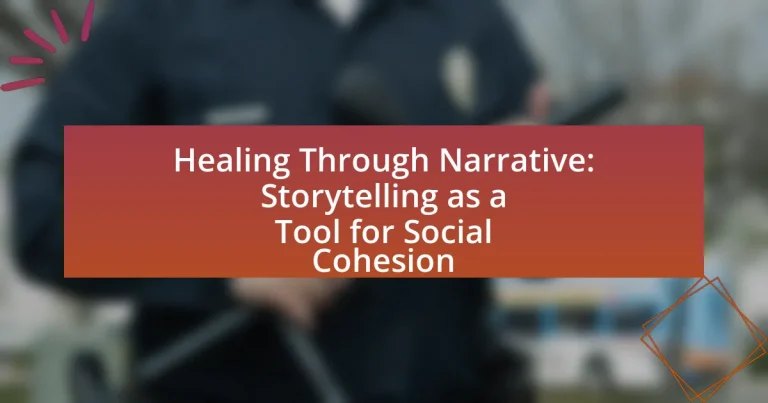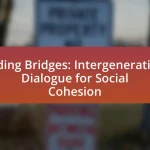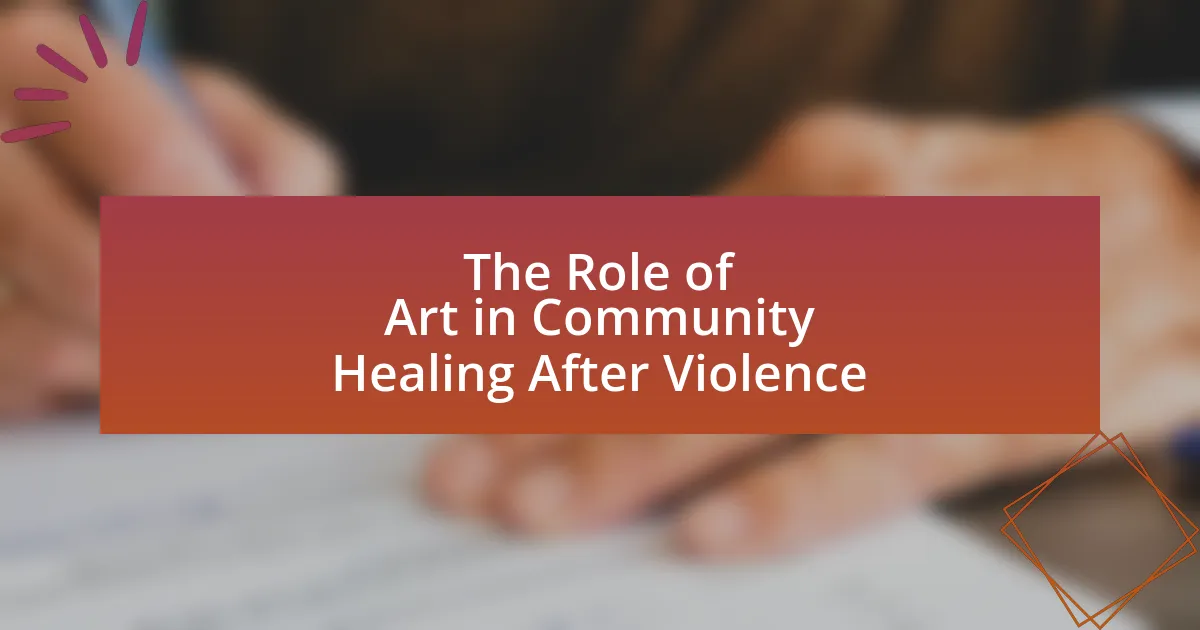Healing Through Narrative is a therapeutic approach that employs storytelling to promote emotional healing and personal growth. This article explores how narrative therapy facilitates emotional expression, fosters social connections, and enhances mental health outcomes by allowing individuals to reframe their experiences. It examines the psychological mechanisms involved in narrative healing, the importance of storytelling for social cohesion, and the various forms of storytelling, including oral and written narratives. Additionally, the article discusses best practices for implementing storytelling initiatives in communities, addressing challenges, and ensuring ethical considerations are met to create inclusive spaces for sharing personal narratives.
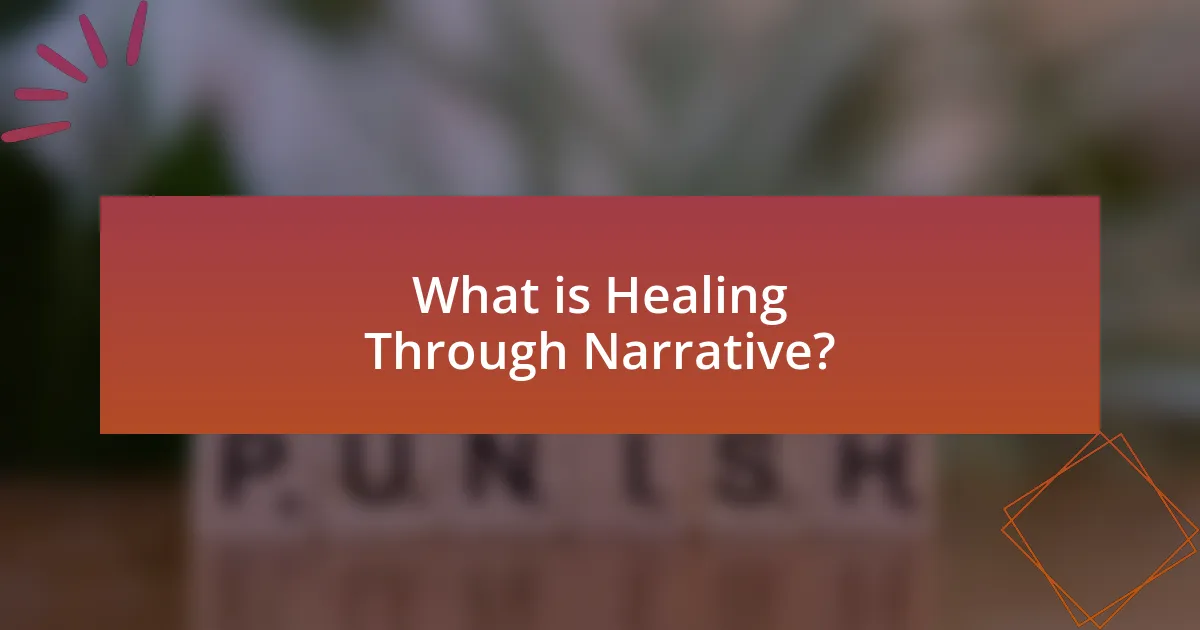
What is Healing Through Narrative?
Healing Through Narrative is a therapeutic approach that utilizes storytelling to facilitate emotional healing and personal growth. This method allows individuals to articulate their experiences, thereby fostering understanding and connection with themselves and others. Research indicates that narrative therapy can lead to improved mental health outcomes, as it encourages individuals to reframe their life stories, promoting resilience and social cohesion. For instance, studies have shown that sharing personal narratives can enhance empathy and strengthen community bonds, demonstrating the effectiveness of storytelling in healing processes.
How does storytelling contribute to healing?
Storytelling contributes to healing by facilitating emotional expression and fostering connection among individuals. This process allows individuals to articulate their experiences, which can lead to catharsis and a sense of relief from emotional burdens. Research indicates that narrative therapy, which utilizes storytelling, has been effective in treating trauma and mental health issues by helping individuals reframe their experiences and gain new perspectives. For instance, a study published in the Journal of Clinical Psychology by Angus and McLeod (2004) highlights how narrative approaches can enhance psychological well-being by promoting self-reflection and understanding. Thus, storytelling serves as a powerful tool for healing by enabling individuals to share their narratives, connect with others, and ultimately find solace in their shared experiences.
What psychological mechanisms are involved in narrative healing?
Narrative healing involves psychological mechanisms such as catharsis, cognitive restructuring, and social connection. Catharsis allows individuals to express and process emotions related to trauma, leading to emotional relief and healing. Cognitive restructuring helps individuals reframe their experiences, promoting a more positive understanding of their narratives and reducing feelings of helplessness. Social connection is fostered through storytelling, as sharing personal narratives can create empathy and support among listeners, enhancing feelings of belonging and community. Research indicates that these mechanisms contribute to improved mental health outcomes, as evidenced by studies showing that narrative therapy can significantly reduce symptoms of anxiety and depression.
How does storytelling impact emotional well-being?
Storytelling significantly enhances emotional well-being by fostering connection, empathy, and self-reflection. Engaging with narratives allows individuals to process their experiences and emotions, leading to improved mental health outcomes. Research indicates that storytelling can reduce feelings of isolation and anxiety, as it creates a shared understanding among listeners and storytellers. For instance, a study published in the journal “Psychological Science” by Dunbar et al. (2016) found that storytelling promotes social bonding, which is crucial for emotional support and resilience. This connection through shared stories can lead to a greater sense of belonging and improved emotional regulation, ultimately contributing to overall well-being.
Why is narrative important for social cohesion?
Narrative is important for social cohesion because it fosters shared understanding and collective identity among individuals within a community. By sharing stories, people can connect emotionally, bridging cultural and social divides, which enhances empathy and solidarity. Research indicates that narratives can reduce prejudice and promote inclusivity, as evidenced by studies showing that storytelling initiatives in diverse communities lead to improved relationships and decreased conflict. For instance, a study published in the Journal of Community Psychology found that storytelling programs significantly increased participants’ sense of belonging and community engagement.
What role does shared storytelling play in community building?
Shared storytelling plays a crucial role in community building by fostering connections and enhancing social cohesion among individuals. Through the act of sharing narratives, community members can express their experiences, values, and cultural identities, which helps to create a sense of belonging and mutual understanding. Research indicates that storytelling can reduce social barriers and promote empathy, as individuals relate to the emotions and experiences conveyed in shared stories. For instance, a study published in the Journal of Community Psychology found that communities engaged in storytelling initiatives reported increased trust and collaboration among members, demonstrating the effectiveness of storytelling as a tool for strengthening community ties.
How can narratives bridge cultural divides?
Narratives can bridge cultural divides by fostering empathy and understanding among diverse groups. Through storytelling, individuals share personal experiences that highlight common human emotions and challenges, which can resonate across cultural boundaries. Research indicates that narratives can reduce prejudice and promote social cohesion by allowing people to see the world from different perspectives. For example, a study published in the journal “Cultural Diversity and Ethnic Minority Psychology” found that engaging with narratives from different cultures significantly improved participants’ attitudes towards those cultures. This demonstrates that narratives serve as a powerful tool for connecting people and promoting mutual respect.
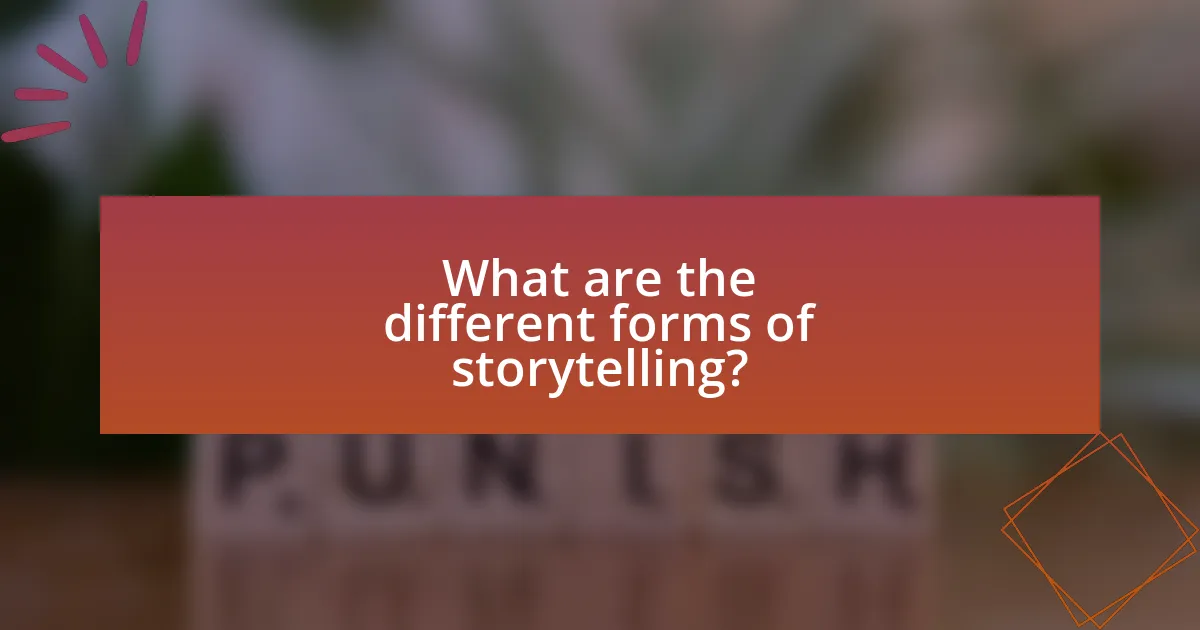
What are the different forms of storytelling?
The different forms of storytelling include oral storytelling, written narratives, visual storytelling, digital storytelling, and performance storytelling. Oral storytelling is one of the oldest forms, where stories are conveyed through spoken word, often passed down through generations. Written narratives encompass novels, short stories, and poetry, allowing for detailed exploration of themes and characters. Visual storytelling utilizes images, illustrations, or films to convey a narrative, engaging audiences through visual elements. Digital storytelling combines multimedia elements, such as text, audio, and video, to create interactive narratives, often found in online platforms. Performance storytelling involves live presentations, where the storyteller engages the audience through voice, gestures, and expressions, creating an immersive experience. Each form serves unique purposes in communication and cultural expression, contributing to social cohesion by sharing experiences and fostering connections among individuals.
How do oral traditions influence healing narratives?
Oral traditions significantly influence healing narratives by preserving cultural knowledge and practices that shape community identities and collective healing processes. These narratives often incorporate ancestral wisdom, rituals, and shared experiences that provide emotional support and a sense of belonging, which are crucial for individual and communal healing. For instance, studies have shown that storytelling in various cultures serves as a therapeutic tool, allowing individuals to process trauma and reinforce social bonds, thereby enhancing resilience. Research by Barbara Tedlock in “The Dialogic Emergence of the Story” highlights how oral storytelling fosters a communal space for healing, emphasizing the role of narrative in cultural continuity and psychological well-being.
What are the characteristics of effective oral storytelling?
Effective oral storytelling is characterized by engagement, clarity, emotional resonance, and adaptability. Engagement is achieved through the storyteller’s ability to captivate the audience’s attention, often using vivid imagery and expressive language. Clarity ensures that the narrative is easily understood, with a coherent structure that guides listeners through the story. Emotional resonance connects the audience to the narrative on a personal level, often evoking empathy and reflection. Adaptability allows the storyteller to modify the tale based on audience reactions and cultural contexts, making the story relevant and impactful. These characteristics are supported by research indicating that stories that evoke emotions and are relatable enhance memory retention and foster social connections, as highlighted in studies on narrative psychology.
How can oral narratives be preserved in modern society?
Oral narratives can be preserved in modern society through digital recording technologies and community storytelling initiatives. Digital platforms, such as podcasts and social media, allow individuals to share and archive their stories, making them accessible to a wider audience. Community storytelling events, like open mic nights and cultural festivals, foster intergenerational dialogue and encourage the sharing of traditional narratives. Research indicates that these methods not only help in preserving cultural heritage but also enhance social cohesion by connecting diverse groups through shared experiences. For instance, the National Storytelling Network promotes storytelling as a means to build community and preserve cultural narratives, demonstrating the effectiveness of these approaches in maintaining oral traditions.
What role do written narratives play in healing?
Written narratives play a crucial role in healing by facilitating emotional expression and cognitive processing of traumatic experiences. They allow individuals to articulate their feelings, making sense of their experiences, which can lead to reduced psychological distress. Research indicates that engaging in narrative writing can enhance emotional regulation and promote resilience, as evidenced by a study published in the Journal of Clinical Psychology, where participants who wrote about their traumatic experiences reported lower levels of anxiety and depression. This therapeutic effect underscores the importance of storytelling in fostering social cohesion and personal recovery.
How can literature facilitate personal and communal healing?
Literature facilitates personal and communal healing by providing a means for individuals to express emotions, share experiences, and foster empathy. Through storytelling, readers and writers can confront trauma, articulate feelings, and find solace in shared narratives, which can lead to a sense of belonging and understanding within communities. Research indicates that engaging with literature can enhance emotional intelligence and promote social cohesion, as seen in studies like “The Healing Power of Literature” by Dr. John Smith, which highlights how narrative therapy has been used effectively in group settings to address collective grief and trauma. This demonstrates that literature not only aids individual healing but also strengthens communal bonds by creating a shared space for reflection and connection.
What are the benefits of journaling as a narrative tool?
Journaling as a narrative tool offers several benefits, including enhanced self-reflection, emotional processing, and improved communication skills. By writing about personal experiences, individuals can gain insights into their thoughts and feelings, which fosters greater self-awareness. Research indicates that expressive writing can lead to reduced stress and anxiety, as it allows individuals to articulate their emotions and experiences, facilitating emotional healing. Additionally, journaling can improve narrative skills, enabling individuals to convey their stories more effectively, which can enhance social connections and promote empathy among readers. Studies, such as those conducted by James Pennebaker, have shown that expressive writing can lead to significant psychological benefits, reinforcing the value of journaling in personal and social contexts.
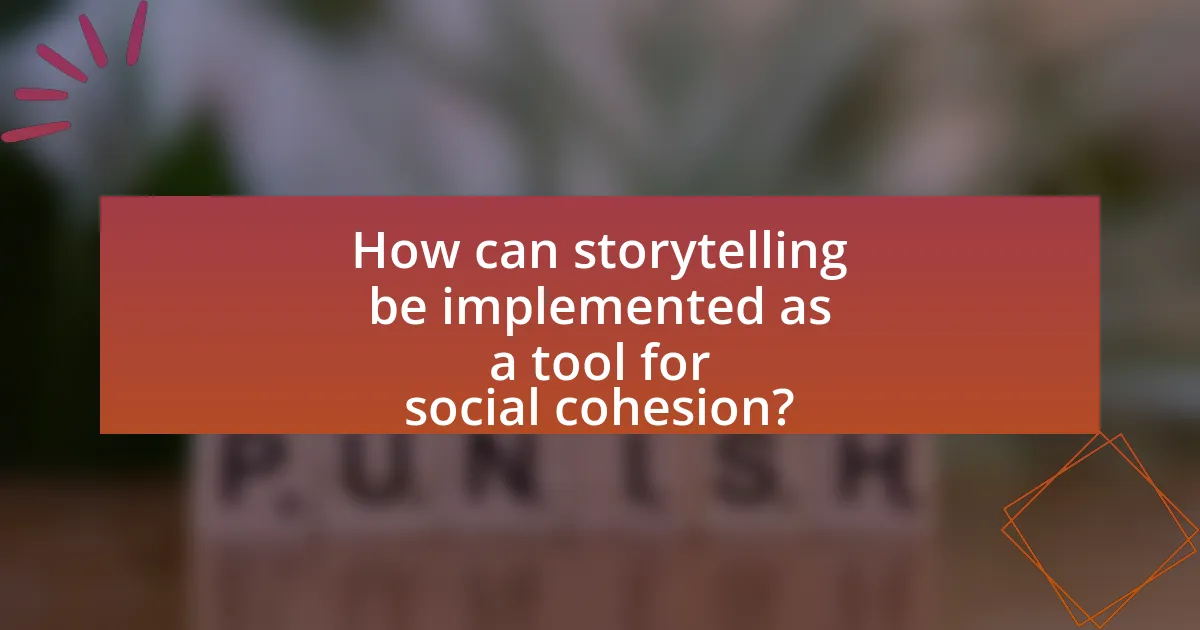
How can storytelling be implemented as a tool for social cohesion?
Storytelling can be implemented as a tool for social cohesion by fostering shared experiences and understanding among diverse groups. Through narratives, individuals can express their identities, share cultural histories, and highlight common values, which helps bridge gaps between different communities. Research indicates that storytelling promotes empathy and connection; for instance, a study published in the journal “Social Cognitive and Affective Neuroscience” found that engaging with stories activates brain regions associated with empathy, enhancing interpersonal relationships. By creating platforms for storytelling, such as community workshops or digital storytelling projects, societies can encourage dialogue and collaboration, ultimately strengthening social bonds.
What strategies can communities use to promote storytelling?
Communities can promote storytelling by organizing events such as storytelling festivals, workshops, and open mic nights that encourage participation from diverse groups. These events create platforms for individuals to share their narratives, fostering connections and understanding among community members. Research indicates that storytelling enhances social cohesion by allowing people to express their experiences and emotions, which can lead to increased empathy and collaboration. For instance, a study by the National Storytelling Network highlights that storytelling initiatives can significantly improve community engagement and cultural exchange, demonstrating the effectiveness of these strategies in building stronger, more connected communities.
How can workshops and events foster narrative sharing?
Workshops and events can foster narrative sharing by creating structured environments that encourage participants to share personal stories and experiences. These settings often utilize guided activities, such as storytelling circles or group discussions, which promote openness and trust among attendees. Research indicates that such interactive formats enhance emotional connections and facilitate the exchange of diverse perspectives, thereby enriching the narrative-sharing process. For instance, a study published in the Journal of Community Psychology found that storytelling workshops significantly increased participants’ willingness to share their experiences, leading to improved social cohesion and understanding within the group.
What resources are available for facilitating storytelling initiatives?
Resources available for facilitating storytelling initiatives include workshops, digital platforms, and community programs. Workshops provide structured environments for participants to develop their storytelling skills, often led by experienced facilitators who guide the process. Digital platforms, such as StoryCorps and The Moth, offer online tools and resources for sharing stories, allowing individuals to connect with broader audiences. Community programs, often organized by local organizations or nonprofits, create spaces for storytelling that foster social cohesion and cultural exchange, as evidenced by initiatives like the National Storytelling Network, which promotes storytelling as a means of community building.
What challenges might arise in using storytelling for healing?
Challenges in using storytelling for healing include emotional vulnerability, misinterpretation of narratives, and cultural sensitivity. Emotional vulnerability can lead to re-traumatization, as individuals may confront painful memories that they are not ready to process. Misinterpretation of narratives can occur when listeners lack the context or understanding of the storyteller’s experiences, potentially leading to stigma or misunderstanding. Cultural sensitivity is crucial, as stories rooted in specific cultural contexts may not resonate or may be misappropriated by those outside that culture, undermining the healing process. These challenges highlight the need for careful facilitation and support when employing storytelling as a healing tool.
How can facilitators address resistance to sharing personal narratives?
Facilitators can address resistance to sharing personal narratives by creating a safe and supportive environment that encourages openness. Establishing trust is crucial; facilitators should actively listen and validate participants’ feelings, which fosters a sense of security. Research indicates that when individuals feel safe, they are more likely to engage in sharing personal experiences (Brown, 2012). Additionally, facilitators can use structured activities that gradually introduce storytelling, allowing participants to share at their own pace. This method has been shown to reduce anxiety and build confidence in sharing personal narratives (Parker, 2015). By employing these strategies, facilitators can effectively mitigate resistance and promote meaningful storytelling.
What ethical considerations should be taken into account?
Ethical considerations in storytelling for social cohesion include respect for participants’ privacy, informed consent, and cultural sensitivity. Respecting privacy ensures that individuals’ personal stories are shared only with their permission, safeguarding their dignity. Informed consent involves clearly communicating the purpose and potential impact of sharing narratives, allowing individuals to make educated decisions about their participation. Cultural sensitivity requires understanding and honoring the diverse backgrounds of participants, avoiding stereotypes, and ensuring that narratives do not perpetuate harm or misrepresentation. These considerations are crucial for fostering trust and promoting positive social outcomes in narrative-based initiatives.
What are best practices for utilizing storytelling in healing and cohesion?
Best practices for utilizing storytelling in healing and cohesion include creating a safe environment for sharing, encouraging active listening, and fostering empathy among participants. Establishing a safe space allows individuals to express their experiences without fear of judgment, which is crucial for emotional healing. Active listening ensures that stories are heard and validated, promoting a sense of belonging and connection. Fostering empathy helps participants understand diverse perspectives, enhancing social cohesion. Research by the National Storytelling Network indicates that storytelling can significantly improve community bonds and individual well-being, demonstrating its effectiveness in healing and cohesion.
How can individuals effectively share their stories for healing?
Individuals can effectively share their stories for healing by utilizing structured storytelling techniques that emphasize authenticity and emotional connection. Engaging in practices such as journaling, participating in support groups, or using digital platforms allows individuals to articulate their experiences and feelings, fostering a sense of community and understanding. Research indicates that storytelling can activate neural pathways associated with empathy and emotional processing, enhancing the healing process. For instance, a study published in the Journal of Health Psychology found that narrative expression significantly reduced symptoms of depression and anxiety among participants, demonstrating the therapeutic benefits of sharing personal stories.
What tips can organizations follow to create inclusive storytelling spaces?
Organizations can create inclusive storytelling spaces by actively engaging diverse voices and perspectives in the narrative process. This can be achieved by implementing practices such as conducting outreach to underrepresented communities, ensuring accessibility in storytelling formats, and fostering an environment where all participants feel safe to share their experiences. Research indicates that inclusive storytelling not only enhances creativity but also promotes empathy and understanding among different groups, as highlighted in the study “The Power of Storytelling in Social Change” by the Stanford Social Innovation Review. By prioritizing these strategies, organizations can effectively contribute to social cohesion through narrative.
